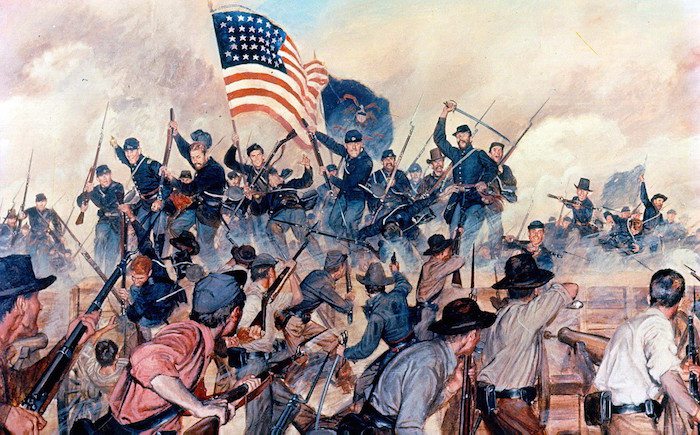above: ‘First at Vicksburg.’ Illustration via the U.S. Army Center of Military History
Is there an American way of war? The question evokes deep controversy, not least because for a very long time, Americans considered themselves an exceptionally peaceful nation. Even into the 20th century, American presidents boasted about the nation’s aversion to war and defense expenditures.
But even during the period in which the United States openly embraced pacifism, its military forces won some remarkable victories.

This article examines five great American victories, spanning from 1780 until 1944. We’re looking for neither technically impressive victories (although most of these are), nor predictable thrashings.
With one major exception, these battles did not turn on chance or on the need for remarkable heroism (although such heroism was always present). Instead, these successes came at the end of well-conceived and executed campaigns, designed to integrate the elements of national power into a strategic victory.
We’re looking at how the United States built a series of advantages that led inexorably to victory, even if the outcome sometimes remained in doubt until the final play.
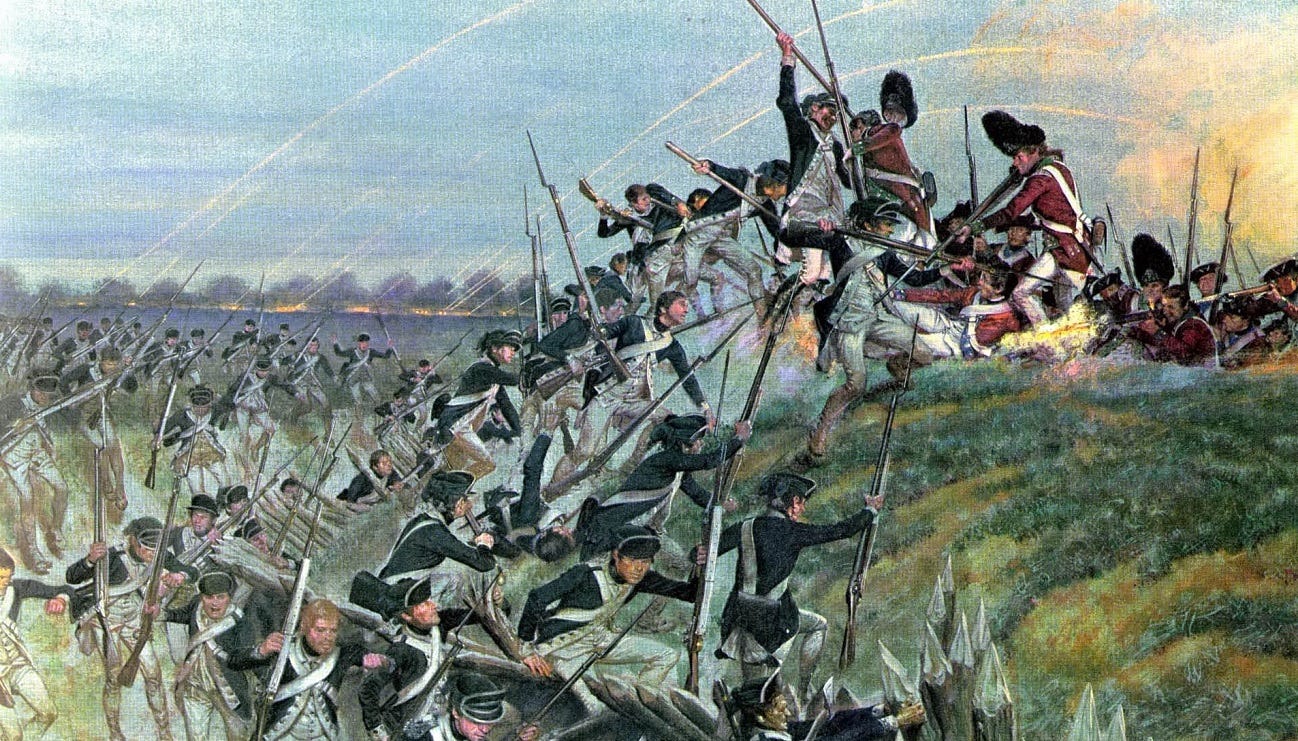
Battle of Yorktown
The Battle of Saratoga decisively ended British attempts to subdue the northern colonies. Although British forces remained in control of certain critical areas (including especially New York City), the focus of British attention turned south. British commanders hoped to rally loyalists, and perhaps to fully detach the southern colonies from the rebellion.
British forces won several major victories, although colonial resistance continued and the loyalist recruits never appeared in the anticipated numbers.
In early 1781, Lord Charles Cornwallis led an invasion of Virginia, in an effort to cut off rebel forces in the south from their sources of supply. Blundering, bad communication, and poor command relationships on the British side led Cornwallis to occupy Yorktown, while waiting for outside support.
Yorktown was defensible, but could also be easily cut off through the effective combination of naval and ground power. Washington and Lafayette saw the opportunity for a major victory, and moved quickly to take advantage.
The French and the colonials executed a series of moves that required exceedingly complex planning, especially given the communications technology of the day.
The siege of Yorktown began on Sept. 28, 1781, and ended with Cornwallis’s surrender on Oct. 19, after the Royal Navy failed to break through. Opponents of the war in the British government quickly took advantage of Cornwallis’ defeat, and peace negotiations soon ensued.
After Great Britain failed to subdue the colonies in the North, some form of eventual independence became extremely likely. The details of that independence, however, depended on the military situation at the conclusion of the peace.
The decisive victory of the Continental Army at Yorktown meant that Britain could not prosecute the war in the south with any hope of success, and that rebel recapture of other outposts was just a matter of time.

Battle of Mexico City
In the spring of 1846, the United States determined, on the flimsiest of pretexts, to appropriate for itself a third of the territory of its only independent neighbor in North America. The United States had recently annexed Texas, and sought to acquire further territories in New Mexico and California.
Early U.S. operations seized key points and won several major battles along the Texas-Mexico border and in California, but Mexico refused to capitulate or negotiate, and Mexican forces had sufficient maneuver space to avoid contact with major U.S. formations. Consequently, success depended on forcing Mexico to accept a political settlement by forcing its most powerful armies to defend it critical national assets.
The campaign to take Mexico City began with an amphibious landing at Veracruz. In early March 1847, Winfield Scott landed with a force of 12,000 men that included many of what would become the luminaries of the Civil War. Scott’s army forced the surrender of the sizable Mexican garrison, and then occupied the city. Scott judged Mexico City to be the center of gravity for the Santa Ana government, and expected that the Mexicans would fight for it.
Scott was correct.
American forces marched west into Mexico’s interior, winning a bloody fight against Santa Ana’s forces in the approaches to Puebla, before capturing the city on May 1. By the beginning of August, Scott had occupied the high ground around Mexico City.
In early September, U.S. forces stormed the city, capturing the Mexican capital. Although engagements continued for several months after the conquest, Mexican forces never seriously threatened to evict Scott, and Mexico eventually agreed to enormous territorial concessions.
While we might be tempted to reflect on the justice of the war, there’s no question that victory in the Mexican-American War fundamentally redrew the map of North America.
The United States acquired vast, thinly populated territories that extended all the way to the Pacific, while Mexico lost nearly a third of its territory. It would be some time before the United States could settle this territory (although statehood for California came quickly), but in purely territorial terms it represents one of the most successful wars of the 19th century.
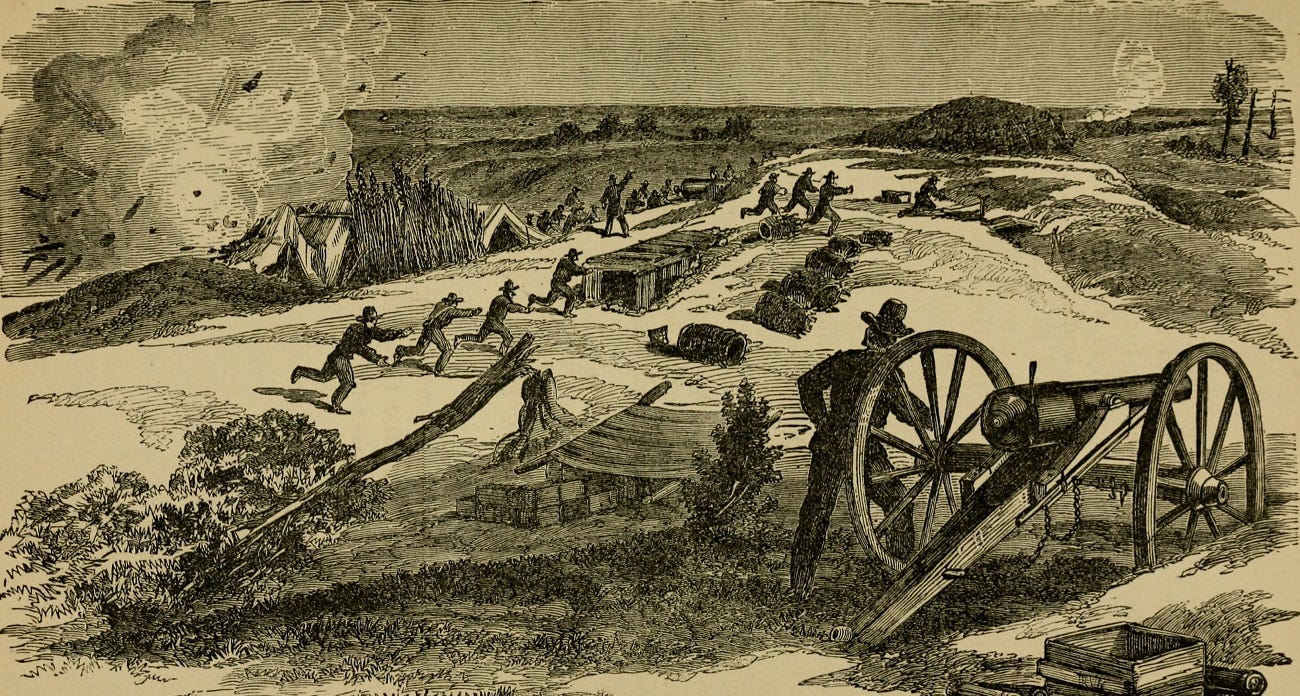
Battle of Vicksburg
The Battle of Vicksburg was the culmination of a six-month Union campaign to seize the most important remaining Confederate fortress on the Mississippi.
The great river system represented both an important Confederate asset, and a serious vulnerability. Control of the river allowed communication between the eastern and western Confederate states, as well as easy north-south movement. In Union hands, however, the river represented a highway into the bowels of the Confederacy.
The operation came primarily under the command of Maj. Gen. Ulysses S. Grant, along with his deputy, Maj. Gen. William T. Sherman. Over a six-month period, Grant and Sherman seized the initiative in the theater of operations, maneuvering and fighting their way across swampy, inhospitable terrain.
The operation was as much a triumph of logistical planning and engineering as a victory of pure arms, with the central Union challenge involving the safe transit of troops to the vicinity of the city.
On May 18, 1863, Grant trapped the out-maneuvered Confederates in Vicksburg itself. The siege of Vicksburg lasted 46 days, with the defenders (led by Lt. Gen. John C. Pemberton) surrendering on July 4.
Vicksburg confirmed Union control of the Mississippi, meaning that Union forces could prevent the western Confederacy from supporting the east. It also confirmed the ascendance of Grant and Sherman to the senior ranks of Union commanders.
It left the underbelly of the Confederacy open to attack by Union armies, and gave thousands of slave the opportunity to make their way to Union lines. Lee recovered from his defeat at Gettysburg, and the armies of the Confederacy remained viable for two more years, especially in the east.
Vicksburg, however, fatally undercut the national unity of the Confederacy, and its ability to manage its own territory.
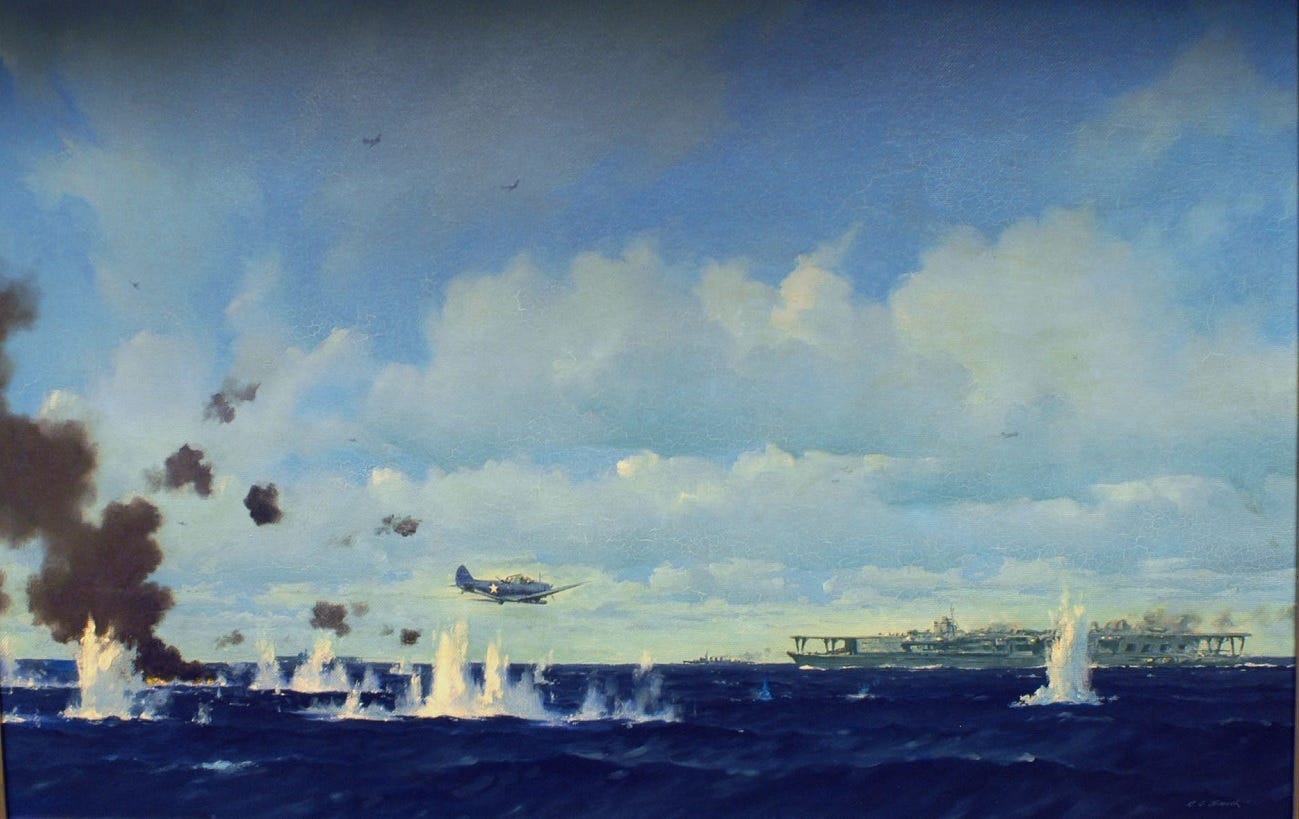
Battle of Midway
In the first six months of 1942, the Imperial Japanese Navy had accomplished nearly every strategic task that it had set for itself.
The IJN had facilitated the seizure the Dutch East Indies, Indochina, Malaya and Singapore; it had destroyed the major units of the Royal Navy in the Far East, and ranged deep into the Indian Ocean; and it had devastated Dutch, Australian, American and British naval strength at engagements from Pearl Harbor to Java Sea.
The most important remaining task was the destruction of the carriers of the U.S. Navy’s Pacific Fleet. The Pearl Harbor attack had damaged or destroyed most of the battleship force, but the three carriers of the Pacific Fleet were on other missions. These carriers would soon be supported by three more, although USS Lexington was lost at the Battle of Coral Sea, which also damaged USS Yorktown and HIJMS Shokaku.
Imperial Japanese Navy Adm. Isoroku Yamamoto decided to attempt to draw out the USN by invading Midway, a small island roughly equidistant between Japan and the United States. If taken, Midway could provide a submarine base capable of supporting attacks on U.S. shipping. The main objective, however, was the destruction of the U.S. fleet.
Apprised of Japanese movements because of code breaking, Nimitz decided to commit his remaining carriers, including the battered USS Yorktown, despite the expected Japanese superiority.
Nimitz had two advantages.
First, U.S. intelligence had a much better command of Japanese dispositions than vice versa. The IJN expected the American carriers to come out and play, but didn’t have a sense of when and where they would attack. Second, the vast fleet of carriers, cruisers and battleships rolling off American production lines gave Nimitz the luxury to engage in risk-acceptant behaviors.
The battle resulted in a devastating American victory.
Japan lost four fleet carriers to American dive-bombers, and the Combined Fleet withdrew from Midway without attempting an invasion. The USN lost only one carrier (USS Yorktown). Japan continued its offensive in other areas, but the presumptive superiority of the IJN was broken.
Japan and the United States would shortly thereafter descend into the bitter slog of Guadalcanal, a campaign of attrition that unavoidably favored the greater resources of the United States.
Midway may not have won the war; Japan continued to fight for three more years, and was probably at the limit of its offensive sphere in any case. Still, it represented a key inflection point of the Pacific War, squaring the score and giving the initiative to the United States.
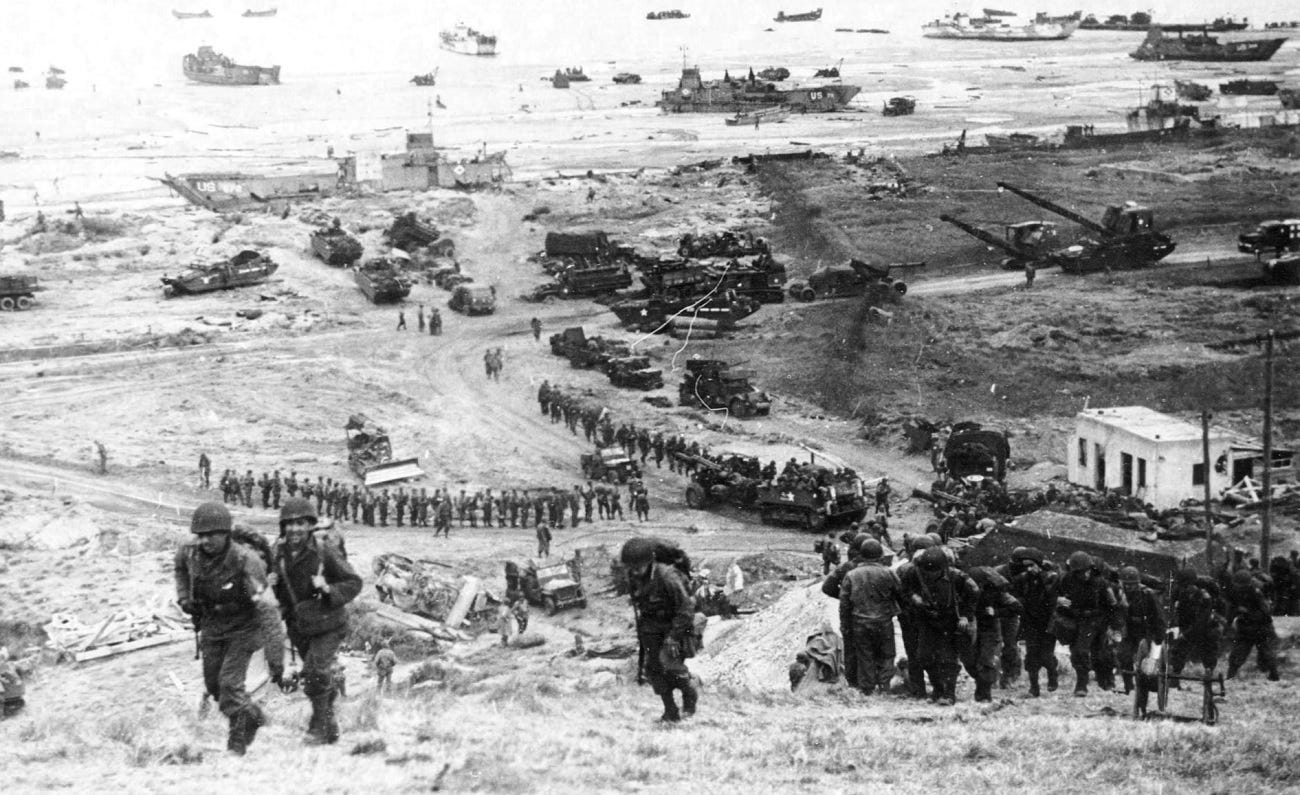
Operation Overlord
On June 6, 1944, the United States and the United Kingdom led a coalition of Allied countries in the invasion of German-controlled France. The operation, painstakingly planned for months (and prepared for even longer) brought U.S. forces into direct conflict with the Wehrmacht in decisive terms, allowing its defeat in the West and facilitating the collapse of Nazi Germany.
Overlord was not a solely American operation, by any standards.
The United Kingdom was an equal partner, and both Canada and Poland made big contributions. Nevertheless, it represented a culmination of the industrial, logistical and intellectual contributions of the United States to the Western alliance, and was made possible by the unique combination of American industrial and military might.
Preparations for Overlord began in mid-1943. Over the next year, the United States and Great Britain would accumulate a massive ground force in southern England, supported by a huge tactical air force and a flotilla of warships and landing craft.
When the Allies struck across a broad front in Normandy, German defenders caused significant casualties, but failed to turn back the attack.
Although the Germans managed to keep the Allies hemmed in for about a month, American forces broke out in late July. With forces able to maneuver in France, the Germans had no hope of putting up an effective defense.
In December 1944, the Wehrmacht launched a surprise, last-ditch offensive against Allied forces in the Ardennes forest. The offensive was intended to drive to the sea, splitting Allied forces in two and forcing the Western Allies to come to terms with Nazi Germany. Successful American resistance at Bastogne halted the German advance, ending the last opportunity for Germany to affect the course of the war.
Conclusion
America is quintessentially modern, and success in modern warfare depends on much more than deeds of heroic valor. Those deeds are undeniably part of victory, but they require context — the ability to aggregate the tools of national power behind a singular purpose.
Since the Revolutionary War, the greatest American military successes have depended on careful, long-range planning, the organization of assets and the commitment to overwhelming the enemy.
The American genius for war, to the extent that it exists, lies in the ability to build advantage so that genius, heroism and chance on the battlefield don’t need to play decisive roles.
The tactical battlefield is nothing like a chessboard, but the operational and strategic fields sure are, and American commanders have proven to be exceedingly adept players.

